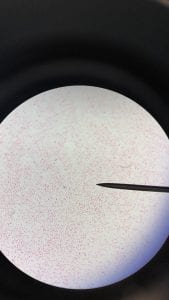What were the results of your 16S analysis?
I ended up getting two of my samples sequenced, #2 and #4. After analyzing the sequences from BLAST I found that #2 was from the Klebsiella genus with 1062 bp and 98% query cover (4). Sample #4 was from the Acinetobacter genus with 790 bp and 99% query cover (4).
Does your Gram stain test agree?
The Gram stain test for #2 matched the results from BLAST of the Klebsiella genus (2). It was a Gram negative bacteria with oval shaped bacteria.
The Gram stain test for #4 did not match with the Acinetobacter genus because this genus is Gram negative (1). I got a Gram positive bacteria with a rod shape from the Gram stain test.
General cellular and morphological characteristics of the genus
Klebsiella is a Gram negative bacteria that is rod shaped (3). It is from the Enterobacterales order and the Enterobacteriaceae family (4). It normally lives in the mouth and gut flora but can be pathogenic (3). It can also be found in soil, water, and plants (3). Almost all Klebsiella can be grown on minimal media with ammonium ions or nitrate (5). Klebsiella grow as yellow, dome-shaped colonies that are also often mucoid (5). They are an anaerobic, non-motile species (3). The Klebsiella genus is resistant to many commonly used antibiotics and is responsible for some nosocomial infections (3). The most common infection is pneumonia which is caused by the species Klebsiella pneumonia, a community acquired pulmonary infection (5).

Picture from Medical-Labs: Medical Laboratories Portal.
Information regarding antibiotic production in this genus
There is not a lot of information about the antibiotics produced by species of Klebsiella. There is, however, a lot of information on the antibiotics they are resistant to, including aminopenicillins and carboxypenicillins (5). Many Klebsiella bacteria produce beta-lactamase which is an enzyme that gives them resistance to certain antibiotics (5).
References
- Nemec, A. et al. “Genotypic and phenotypic characterization of the Acinetobacter
calcoaceticuse Acinetobacter baumannii complex with the proposal of
Acinetobacter pittii sp. nov. (formerly Acinetobacter genomic species 3)
and Acinetobacter nosocomialis sp. nov. (formerly Acinetobacter
genomic species 13TU)”. Research in Microbiology, vol. 162, 2011, pp. 393-404. - Diene, S. et al. “The Rhizome of the Multidrug-Resistant Enterobacter aerogenes Genome Reveals How New “Killer Bugs” Are Created because of a Sympatric Lifestyle”. Molecular Biology and Evolution, vol. 30, no. 2, 2013, pp. 369–383.
- Buckle, Jane. Clinical Aromatherapy. Elsevier, 2015.
- BLAST, NCBI, 2018. Accessed 11 November 2018.
- Brisse, S. Grimont, F., & P. Grimont. The Prokaryotes. Springer, 2006, pp. 159-196.



